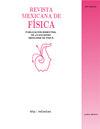Green chemistry synthesis and structural and optical study of Dy2(CO3)3→ Dy2O3 transition
IF 1.2
4区 物理与天体物理
Q3 PHYSICS, MULTIDISCIPLINARY
引用次数: 0
Abstract
This paper presents preliminary results of Dy2(CO3)3→Dy2O3 transition have been successfully obtained by Chemical Bath Deposition technical and subsequent thermal annealing temperature at ~600 °C. Two different temperatures of ~20°C and ~90 °C ± 2 °C are chosen to carry out the nanocrystalline growth. The crystalline phase is investigated by applying X-Ray Diffraction (XRD) and some optical properties; Transmittance, Reflectivity, Normalized Absorbance, real (n) and imaginary (k) parts refractive index. The crystalline phase of these inorganic nanomaterials for Dy2(CO3)3 is orthorhombic phase, while for Dy2O3 it is cubic. Grain size average values located at ranged ~2.8-3.4 nm for Dy2(CO3)3 and ~6.5-9.6 nm for Dy2O3. Vibrational modes are identified by Raman spectroscopy, modes at ~150-1800 cm-1 frequency range assigned to internal vibrations of ion: v1-symmetric stretching (~1098 cm-1) v3-asymmetric -C-O stretching situated at ∼1063 cm-1, were observed corresponding to orthorhombic crystalline phase. The Fg+ Ag and A1g modes, corresponding to cubic phase Dy2O3. Multiple absorption bands with different relative intensities are observed at UV-Vis-NIR region, assigned to 4fs→4fs intra-electronic transitions and band gap energy. Absorption measurement were assigned to the transitions from ground state (6H15/2) to different excited states such as 4I13/2→4F7/2, 4I15/2, 6F3/2, 6F5/2, 6F7/2→6H5/2, 6F9/2→6H7/2, 6F11/2→6H9/2 and 6H11/2 of Dy3+ cation. Tauc’s plot reveals band gap situated at range ~4.66-5.17 eV for Dy2(CO3)3 and ~4.26-4.80 eV for Dy2O3 respectively.Dy2(CO3)3→Dy2O3跃迁的绿色化学合成及结构光学研究
采用化学浴沉积技术,在~600℃的温度下,成功地获得了Dy2(CO3)3→Dy2O3转变的初步结果。选择~20℃和~90℃±2℃两种不同的温度进行纳米晶生长。利用x射线衍射(XRD)和光学性质对晶体物相进行了研究;透光率,反射率,归一化吸光度,实部(n)和虚部(k)折射率。这些无机纳米材料中Dy2(CO3)3的晶相为正交相,而Dy2O3的晶相为立方相。Dy2(CO3)3晶粒尺寸平均值为~2.8 ~ 3.4 nm, Dy2O3晶粒尺寸平均值为~6.5 ~ 9.6 nm。通过拉曼光谱识别振动模式,在~150 ~ 1800 cm-1频率范围内的振动模式分配给离子内部振动:v1-对称拉伸(~1098 cm-1) v3-不对称-C-O拉伸位于~ 1063 cm-1,与正交晶相对应。Fg+ Ag和A1g模式,对应于立方相Dy2O3。在UV-Vis-NIR区观察到多个相对强度不同的吸收带,分别为4fs→4fs电子内跃迁和带隙能。对Dy3+阳离子从基态(6H15/2)到不同激发态(4I13/2→4F7/2、4I15/2、6F3/2、6F5/2、6F7/2→6H5/2、6F9/2→6H7/2、6F11/2→6H9/2、6H11/2→6H9/2、6H11/2)的跃迁进行吸收测量。Tauc图显示Dy2(CO3)3的带隙介于~4.66 ~ 5.17 eV和Dy2O3的带隙介于~4.26 ~ 4.80 eV之间。
本文章由计算机程序翻译,如有差异,请以英文原文为准。
求助全文
约1分钟内获得全文
求助全文
来源期刊

Revista Mexicana De Fisica
物理-物理:综合
CiteScore
2.20
自引率
11.80%
发文量
87
审稿时长
4-8 weeks
期刊介绍:
Durante los últimos años, los responsables de la Revista Mexicana de Física, la Revista Mexicana de Física E y la Revista Mexicana de Física S, hemos realizado esfuerzos para fortalecer la presencia de estas publicaciones en nuestra página Web ( http://rmf.smf.mx).
 求助内容:
求助内容: 应助结果提醒方式:
应助结果提醒方式:


